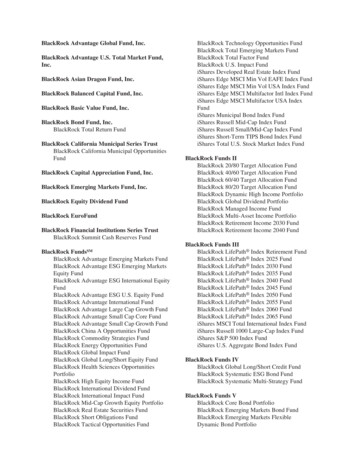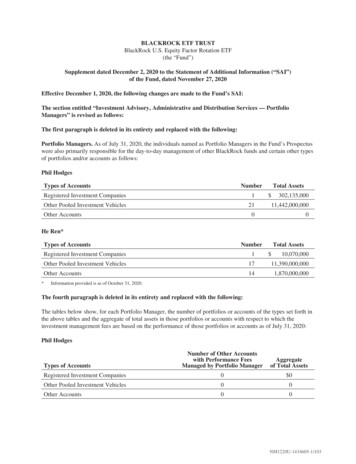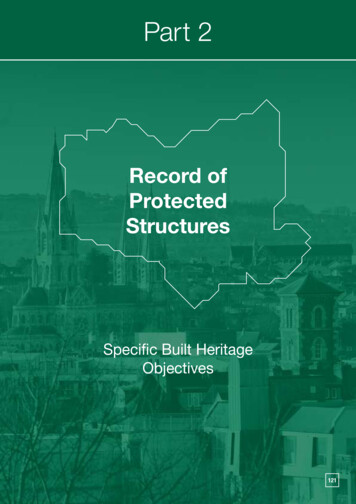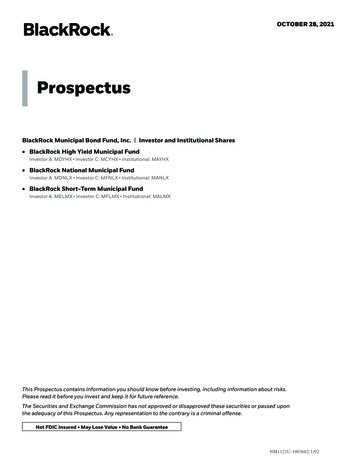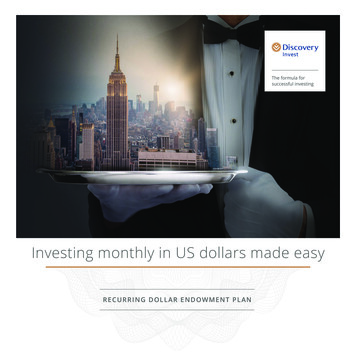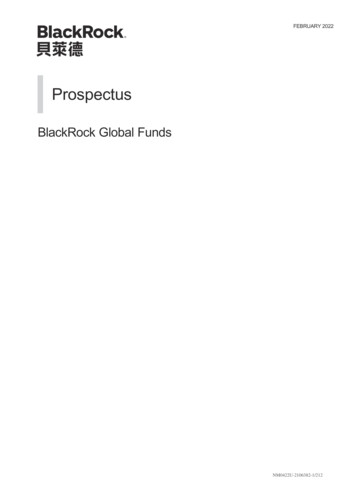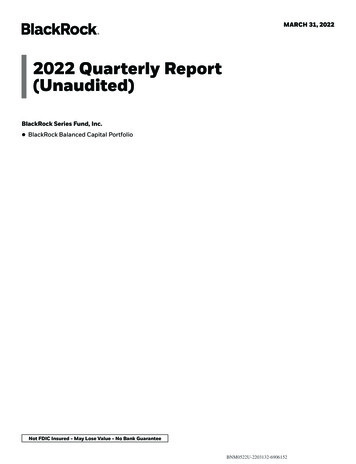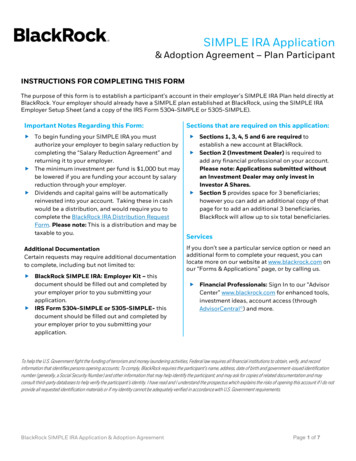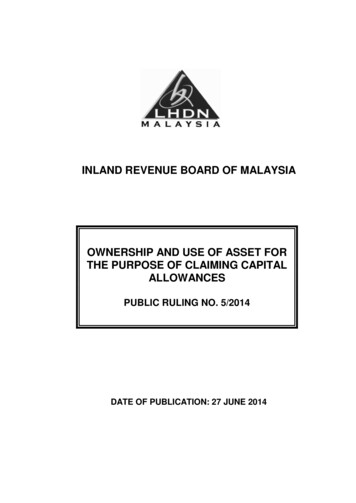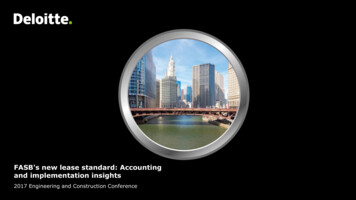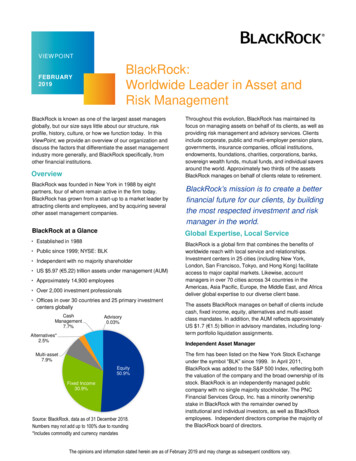
Transcription
VIEW POINTBlackRock:Worldwide Leader in Asset andRisk ManagementFEBRUARY2019BlackRock is known as one of the largest asset managersglobally, but our size says little about our structure, riskprofile, history, culture, or how we function today. In thisViewPoint, we provide an overview of our organization anddiscuss the factors that differentiate the asset managementindustry more generally, and BlackRock specifically, fromother financial institutions.OverviewThroughout this evolution, BlackRock has maintained itsfocus on managing assets on behalf of its clients, as well asproviding risk management and advisory services. Clientsinclude corporate, public and multi-employer pension plans,governments, insurance companies, official institutions,endowments, foundations, charities, corporations, banks,sovereign wealth funds, mutual funds, and individual saversaround the world. Approximately two thirds of the assetsBlackRock manages on behalf of clients relate to retirement.BlackRock was founded in New York in 1988 by eightpartners, four of whom remain active in the firm today.BlackRock has grown from a start-up to a market leader byattracting clients and employees, and by acquiring severalother asset management companies.BlackRock’s mission is to create a betterfinancial future for our clients, by buildingthe most respected investment and riskmanager in the world.BlackRock at a GlanceGlobal Expertise, Local Service Established in 1988 Public since 1999; NYSE: BLK Independent with no majority shareholder US 5.97 ( 5.22) trillion assets under management (AUM) Approximately 14,900 employees Over 2,000 investment professionals Offices in over 30 countries and 25 primary investmentcenters s*2.5%BlackRock is a global firm that combines the benefits ofworldwide reach with local service and relationships.Investment centers in 25 cities (including New York,London, San Francisco, Tokyo, and Hong Kong) facilitateaccess to major capital markets. Likewise, accountmanagers in over 70 cities across 34 countries in theAmericas, Asia Pacific, Europe, the Middle East, and Africadeliver global expertise to our diverse client base.The assets BlackRock manages on behalf of clients includecash, fixed income, equity, alternatives and multi-assetclass mandates. In addition, the AUM reflects approximatelyUS 1.7 ( 1.5) billion in advisory mandates, including longterm portfolio liquidation assignments.Independent Asset ManagerMulti-asset7.9%Equity50.9%Fixed Income30.9%Source: BlackRock, data as of 31 December 2018.Numbers may not add up to 100% due to rounding*Includes commodity and currency mandatesThe firm has been listed on the New York Stock Exchangeunder the symbol “BLK” since 1999. In April 2011,BlackRock was added to the S&P 500 Index, reflecting boththe valuation of the company and the broad ownership of itsstock. BlackRock is an independently managed publiccompany with no single majority stockholder. The PNCFinancial Services Group, Inc. has a minority ownershipstake in BlackRock with the remainder owned byinstitutional and individual investors, as well as BlackRockemployees. Independent directors comprise the majority ofthe BlackRock board of directors.The opinions and information stated herein are as of February 2019 and may change as subsequent conditions vary.
Key Dates in BlackRock HistoryThe Asset Management BusinessFiduciary to ClientsAsset managers, also known as investment managers, arehired by asset owners to invest assets on their behalf. Assuch, asset managers act as fiduciaries, which means actingin the best interests of the client and faithfully executing theinvestment mandate provided by the client. Asset managersinvest within the guidelines specified by their clients for agiven mandate, as set out in the investment managementagreement (IMA) or established by the offering or constituentdocuments that establish the fund. Importantly, the investment results, whether positive or negative, belong to the client.Client Assets held by CustodiansThe assets under management (AUM) are owned by clients.They are generally held by third-party custodians selectedby – and with contractual obligations to – these clients. Thethird-party custodian maintains the official books and recordsand facilitates trade settlement with counterparties. As such,asset managers do not have physical control or directaccess to clients’ assets. Likewise, the client, not the assetmanager, is the counterparty to trades. Consequently, assetmanagers have small balance sheets relative to other typesof financial institutions.Stable Income and Alignment of InterestsAsset managers are generally paid fees for services on a setschedule applied to client AUM. As a result, the assetmanagers' interests are aligned with their clients’. This feestructure generates a more stable income stream than thatof a transaction-oriented financial institution. Also, assetmanagers generally have little debt on their balance sheetsand they do not rely on short-term funding markets.ASSET MANAGERS DO: Act on behalf of clients Rely on a generally stable fee-based income stream Receive regulatory oversight at both the manager andportfolio levelsASSET MANAGERS DO NOT: Invest with their own balance sheets by engaging inprincipal trades Employ balance sheet leverage Guarantee investor principal, nor do they offer agovernment guarantee or backing Provide liquidity for funds Have access to central bank liquidityWhat Distinguishes Asset ManagersWithin the Financial Industry?The Agency ModelAsset managers are characterized by a business model thatis fundamentally different than other financial institutions,such as commercial banks, investment banks, insurancecompanies and government-sponsored entities. Assetmanagers differ from most other financial firms in that theyact as agents managing other people’s money. While assetmanagers do not use their balance sheets in the ordinaryconduct of their business, other financial companies such asbanks engage in activities involving significant levels ofbalance sheet risk.2
For example, investment banks act as principal in trading,market-making and prime brokerage; finance companiesaccess the capital markets for funds and re-lend thesemonies; and insurance companies provide long-termfinancing for real estate and other hard assets as part of theirasset-liability management.Another critical difference between a commercial bank andan asset manager is the absence of reliance on governmentguarantees or support. Banks accept deposits that, in theUS, are then insured by the Federal Deposit InsuranceCorporation and, in the EU, are obliged to participate innational deposit guarantee schemes. Asset managers,meanwhile, clearly disclose to clients that investmentperformance is not guaranteed by the manager, thegovernment, or any other party.These distinctions were critically important in shielding assetmanagement companies from much of the turmoil thatoccurred during the Global Financial Crisis of 2008. Notably,no asset manager was among the 700 US financialinstitutions that received a direct investment under theTroubled Asset Relief Program Capital Purchase Program. 1Asset Management ProductsInvestment strategies can be offered in a variety ofstructures, which can be broken down into two maincategories – collective investment vehicles (CIVs) andseparate accounts.Collective Investment VehiclesCIVs play an important role in many clients’ portfolios. Someclients prefer these investment vehicles for the diversificationthey provide. Examples of CIVs include mutual funds,Undertakings for Collective Investment in TransferableSecurities (UCITS), exchange-traded funds (ETFs),collective trust funds, hedge funds, and alternativeinvestment funds (AIFs).CIVs are typically subject to a robust set of regulatoryrequirements that can differ by the type of client able toinvest in the fund (e.g., individual or institutional) and thejurisdiction(s) in which the fund is offered. Examples ofregulatory regimes that CIVs are subject to include theInvestment Company Act of 1940 in the US or the UCITS VDirective in the European Union (EU). CIVs are separatelegal entities from the asset manager. They are typicallyoverseen by a board of directors or equivalent (such astrustees).Separate AccountsSeparate accounts are individual portfolios managed for asingle client – they can be thought of as a ‘fund for one’.Since the client is the legal owner of the assets in theseparate account, these portfolios are subject to theregulation that the client is subject to. Asset managers hiredto manage separate accounts in the EU, Iceland,Lichtenstein, and Norway are likely to comply with MiFID II,and with the Investment Advisers Act of 1940 for separateaccounts managed in the US.BlackRock’s Largest LocationsRank*CityCountryAmericas (over 7,700 employees)**1New York, NYUnited States2San Francisco, CAUnited States3Wilmington, DEUnited States4Princeton, NJUnited States5Seattle, WAUnited States6Boston, MAUnited States7Mexico CityMexico8Los Angeles, CAUnited States9TorontoCanada10Philadelphia, PAUnited StatesEurope (over 4,100 employees)1LondonUnited Kingdom2EdinburghUnited ands9ParisFrance10MunichGermanyAsia Pacific (over 3,000 employees)1GurgaonIndia2Hong loreIndia10SeoulSouth Korea1 US Government Accountability Office; Office of Special Inspector General for the Troubled Asset Relief Program; US Department of Treasury.*Rank by number of employees. Data as of 31 December 2018.**Includes United States, Canada, Central America, and South America3
Regulation of Asset Managers andAsset ManagementAsset managers are subject to comprehensive regulationthat includes regular examinations and reporting requiringthem to establish and maintain extensive risk managementand compliance policies and procedures.In the USThe Securities and Exchange Commission is the primaryregulator of asset managers that are registered asinvestment advisors. Asset managers that operate trustbanks are overseen by the Office of the Comptroller of theCurrency if federally chartered, and by state bankingauthorities if state chartered.Many asset managers are also subject to regulation by theDepartment of Labor under the Employee RetirementIncome Security Act for work on behalf of certain pensionplans and by the Commodity Futures Trading Commission ifthey invest client funds in commodities or certain derivativesinstruments. The Dodd-Frank Wall Street Reform andConsumer Protection Act (Dodd-Frank), enacted in July2010, introduced a host of new rules that provide forenhanced reporting, oversight and transparency for financialinstruments and financial institutions, including assetmanagers.In EuropeThe vast majority of the legislation that underpins theregulatory environment for asset managers and their activitiesin the EU is agreed upon at the pan-European level.Common European rules create the legislative conditions forthe Single Market in goods, services and people in the EU.Once agreed at the pan-EU level, legislation is subsequentlyimplemented at the national level by Member States, i.e. thecountries that are part of the EU. EU-based asset managersare subject to, among other pieces of regulation, the UCITSDirective (which allows mainstream CIVs to be sold crossborder), the AIFM Directive (ruling alternative investmentmanagers and their funds); and MiFID II (on investmentmanagement services and transaction reporting, amongmany other things).The supervision of asset managers and their services inEurope continues to be carried out by national authorities,such as the Financial Conduct Authority in the UK, theFederal Financial Supervisory Authority in Germany, theAutorité des Marchés Financiers in France and the Authorityfor the Financial Markets in the Netherlands.In Asia-PacificNational authorities in the Asia-Pacific region regulate assetmanagers and asset management products. Regulatoryagencies in the region include the Japan Financial ServicesAgency, the Hong Kong Securities and Futures Commission,the Australian Securities and Investments Commission, theMonetary Authority of Singapore, the China SecuritiesRegulatory Commission, the Korean Financial ServicesCommission, the Taiwan Financial Supervisory Commission,and the Securities and Exchange Board of India.What Differentiates BlackRock?Stand-alone Investment Management CompanyBlackRock was founded as a stand-alone investmentmanagement company focused on providing asset and riskmanagement services to clients. The firm brings togetherexpertise across capital market sectors as well as assetallocation, portfolio management, financial modeling, andrisk management disciplines.CultureAt BlackRock, we understand culture as our sharedunderstanding of who we are, what we stand for and how weconduct ourselves.BlackRock’s culture has been a key part of its success sinceit was established in 1988. BlackRock’s culture is definedthrough the BlackRock Principles, which guide employeeson how best to achieve the firm’s mission to create a betterfinancial future for its clients. Its unifying focus on OneBlackRock has been fundamental to the firm’s constantinnovation, thirst for technological solutions and focus on riskmanagement, combined with an unwavering fiduciaryresponsibility to clients and a commitment to client service.The BlackRock Principles We are a Fiduciary We are passionate about Performance We are One BlackRock We are InnovatorsWe operate our business with a fiduciary responsibility,which means to act in the best interest of our clients. Theirtrust and confidence in us is our most valuable asset, andwe seek to earn it every day.4
We are passionate about our work and intensely focused onperforming at the highest levels. We take emotionalownership of every aspect of the work we do. We prizestrong subject matter expertise and an insatiable appetite tolearn. The firm’s unifying focus on One BlackRock meanswe challenge ourselves – and each other – to collectivelyraise our game. The best solutions result from the ideas andcontributions of a diverse team of partners.Continuous innovation helps us bring the best of BlackRockto our clients. This requires that we are respectfully antibureaucratic, and that we challenge the status quo.State-of-the-art Proprietary Risk Analysis TechnologyAn integral part of BlackRock’s identity is the core belief thatrigorous risk management is critical to the delivery of highquality asset management services.The firm’s leaders identified a growing gap between the sellside and the buy-side, and had a vision for a tool that assetmanagers needed to prudently manage risk.Having determined in 1988 that no existing system adequatelyfulfilled this need, BlackRock designed and built a proprietarystate-of-the-art system, which evolved into the technologyplatform known as BlackRock Solutions (see overleaf).Today, portfolio managers throughout BlackRock have accessto proprietary technology which enables them to make betterinformed decisions. These tools can analyze individualsecurities, aggregate a portfolio of securities, and comparethat portfolio and its risk characteristics to an index or anotherrelevant benchmark.GLOBAL PUBLIC POLICY GROUPIn the last decade in particular, policy and regulation have shaped the landscape in which asset owners and their assetmanagers operate. BlackRock believes engaging on financial regulatory reform is important for our end-clients, the endinvestors, who provide capital to the real economy.BlackRock’s Global Public Policy Group regularly and actively engages in discussions with policymakers on a wide rangeof financial regulatory topics. We support the creation of a regulatory regime that increases transparency, protectsinvestors and facilitates responsible growth of capital markets, while preserving consumer choice and assessing benefitsversus implementation costs. Our views on policy issues, discussed at the global, regional or national level (in the form ofresponses to public consultations and white papers called ViewPoints) are available on the Public Policy website.BLACKROCK INVESTMENT STEWARDSHIPBlackRock Investment Stewardship contributes to the mission of creating a better financial future for our clients bymonitoring and engaging with companies around the globe to encourage them to adopt business practices consistent withsustainable long-term value creation.The BlackRock Investment Stewardship team, made up of over 40 professionals, has a local presence. We work in officesacross the Americas, Europe, and the Asia-Pacific region in order to gain investment insight at the local level, collectivelyvoting approximately 17,000 meetings annually. The team is responsible for: Protecting and enhancing the value of clients' assets through engagement with companies, including proxy voting, inclients’ best long-term economic interests Encouraging business and management practices that in our experience support sustainable financial performanceover the long term Providing insight on environmental, social and governance considerations to BlackRock’s investment strategies,whether indexed or actively managed Engaging clients to build understanding of our work and how it aligns with the firm’s mission Participating in market-level dialogue to understand and contribute to the development of policies and practices thatsupport long-term investing and value creationThe team’s engagement priorities, guidelines, voting and engagement reports, and commentaries are publicly availableon the Investment Stewardship website.5
BLACKROCK INVESTMENT INSTITUTEThe BlackRock Investment Institute (BII) helps BlackRock’s portfolio managers become even better investors andproduces thought-provoking investment-related content for clients and policymakers. The BII team comprises over 30investment professionals spread around the globe. We work closely with investment, economic, policy and politicalexperts across BlackRock to ensure our insights capture the best of BlackRock’s thinking.The BII team is responsible for: Providing connectivity between BlackRock’s portfolio managers to help them debate and tackle key investment issues Originating economic and markets research, including developing proprietary BlackRock tools that aim to gauge wherekey macro indicators are heading Developing investment and asset allocation views for clients across regions and asset classes that reflect the thinkingof BlackRock’s leading portfolio managers Creating client publications and data visuals that highlight BlackRock’s best investment thinking, and showcase ourthought leadership in investing, risk management, portfolio construction and trading solutionsThe BII’s various reports, bulletins and papers are publicly available on the BlackRock Investment Institute website.FINANCIAL MARKETS ADVISORY GROUPThe Financial Markets Advisory Group (FMA) advises clients in managing their capital markets exposure and businesses.FMA focuses on enterprise risk management, regulatory reporting support, complex financial modeling, balance sheetand financial strategy development, and specialized asset management and transaction support services. The FMAteam uses customized analytical and modeling techniques, as well as BlackRock Solutions suite of data management,financial modeling and risk management tools in executing these advisory engagements.BLACKROCK SOLUTIONS Risk-informed investment management requires the right tools to assess security- and portfolio-level risks, to rebalanceportfolios to meet portfolio manager objectives, and to process transactions efficiently. As a result, BlackRock developedan integrated suite of investment management tools designed to be used by BlackRock’s investment professionals.Starting in 2000, BlackRock began offering those risk analytics and trade processing tools, as well as advisory services,to external clients under the BlackRock Solutions brand.Risk Analysis and Investment Processing ToolsThe Aladdin Institutional Business delivers our risk analysis and investment processing tools, known as Aladdin , toinstitutional clients including asset managers, insurers, banks, pensions, and official institutions. Aladdin allows clientorganizations to combine risk analytics, order management, and trade processing on a single platform. This can helpeliminate redundant data input across multiple systems, enhance data integrity through shared and transparentinformation, and increase operating efficiencies and controls.Whilst proprietary technology platforms may help manage risk, risk cannot be eliminated.RELATED CONTENTA complete library of ViewPoint public policy papers, comment letters, and responses to consultations prepared by BlackRock is available atwww.blackrock.com/publicpolicy.6
This publication represents the regulatory and public policy views of BlackRock. The opinions expressed herein are as of February 2019 and are subjectto change at any time due to changes in the market, the economic or regulatory environment or for other reasons. The information in this publicationshould not be construed as research or relied upon in making investment decisions with respect to a specific company or security or be used as legaladvice. Any reference to a specific company or security is for illustrative purposes and does not constitute a recommendation to buy, sell, hold or directlyinvest in the company or its securities, or an offer or invitation to anyone to invest in any BlackRock funds and has not been prepared in connection withany such offer. There is no guarantee that any forecasts made will come to pass. Reliance upon information in this material is at the sole discretion ofthe reader.In the U.S., this material is intended for public distribution. In the EU, issued by BlackRock Investment Management (UK) Limited (authorised andregulated by the Financial Conduct Authority). Registered office: 12 Throgmorton Avenue, London, EC2N 2DL. Registered in England No. 2020394. Tel:020 7743 3000. For your protection, telephone calls are usually recorded. BlackRock is a trading name of BlackRock Investment Management (UK)Limited. This material is for distribution to Professional Clients (as defined by the FCA Rules) and Qualified Investors and should not be relied upon byany other persons. For qualified investors in Switzerland, this material shall be exclusively made available to, and directed at, qualified investors asdefined in the Swiss Collective Investment Schemes Act of 23 June 2006, as amended. Issued in the Netherlands by the Amsterdam branch office ofBlackRock Investment Management (UK) Limited: Amstelplein 1, 1096 HA Amsterdam, Tel: 020 - 549 5200. In South Africa, please be advised thatBlackRock Investment Management (UK) Limited is an authorised Financial Services provider with the South African Financial Services Board, FSP No.43288. In Dubai: This information can be distributed in and from the Dubai International Financial Centre (DIFC) by BlackRock Advisors (UK) Limited —Dubai Branch which is regulated by the Dubai Financial Services Authority (‘DFSA’) and is only directed at ‘Professional Clients’ and no other personshould rely upon the information contained within it. Neither the DFSA or any other authority or regulator located in the GCC or MENA region hasapproved this information. This information and associated materials have been provided to you at your express request, and for your exclusive use.This document is not intended for distribution to, or use by, any person or entity in any jurisdiction or country where such distribution would be unlawfulunder the securities laws of such. Any distribution, by whatever means, of this document and related material to persons other than those referred toabove is strictly prohibited. In Singapore, this is issued by BlackRock (Singapore) Limited (Co. registration no. 200010143N). In Hong Kong, thismaterial is issued by BlackRock Asset Management North Asia Limited and has not been reviewed by the Securities and Futures Commission of HongKong. In Korea, this material is for Professional Investors only. In Japan, this is issued by BlackRock Japan. Co., Ltd. (Financial Instruments BusinessOperator: The Kanto Regional Financial Bureau. License No375, Association Memberships: Japan Investment Advisers Association, the InvestmentTrusts Association, Japan, Japan Securities Dealers Association, Type II Financial Instruments Firms Association.) for Professional Investors only(Professional Investor is defined in Financial Instruments and Exchange Act). In Taiwan, independently operated by BlackRock InvestmentManagement (Taiwan) Limited. Address: 28/F, No. 95, Tun Hwa South Road, Section 2, Taipei 106, Taiwan. Tel: (02)23261600. In Australia, issued byBlackRock Investment Management (Australia) Limited ABN 13 006 165 975, AFSL 230 523 (BIMAL). This material is not a securities recommendationor an offer or solicitation with respect to the purchase or sale of any securities in any jurisdiction. The material provides general information only anddoes not take into account your individual objectives, financial situation, needs or circumstances. Before making any investment decision, you shouldtherefore assess whether the material is appropriate for you and obtain financial advice tailored to you having regard to your individual objectives,financial situation, needs and circumstances. BIMAL, its officers, employees and agents believe that the information in this material and the sources onwhich it is based (which may be sourced from third parties) are correct as at the date of publication. While every care has been taken in the preparationof this material, no warranty of accuracy or reliability is given and no responsibility for the information is accepted by BIMAL, its officers, employees oragents. Any investment is subject to investment risk, including delays on the payment of withdrawal proceeds and the loss of income or the principalinvested. While any forecasts, estimates and opinions in this material are made on a reasonable basis, actual future results and operations may differmaterially from the forecasts, estimates and opinions set out in this material. No guarantee as to the repayment of capital or the performance of anyproduct or rate of return referred to in this material is made by BIMAL or any entity in the BlackRock group of companies. In China, this material may notbe distributed to individuals resident in the People's Republic of China ("PRC", for such purposes, excluding Hong Kong, Macau and Taiwan) or entitiesregistered in the PRC unless such parties have received all the required PRC government approvals to participate in any investment or receive anyinvestment advisory or investment management services. For other APAC countries, this material is issued for Institutional Investors only (orprofessional/sophisticated/qualified investors, as such term may apply in local jurisdictions) and does not constitute investment advice or an offer orsolicitation to purchase or sell in any securities, BlackRock funds or any investment strategy nor shall any securities be offered or sold to any person inany jurisdiction in which an offer, solicitation, purchase or sale would be unlawful under the securities laws of such jurisdiction. In Canada, this materialis intended for permitted clients only. In Latin America and Iberia, this material is for educational purposes only and does not constitute investmentadvice nor an offer or solicitation to sell or a solicitation of an offer to buy any shares of any fund (nor shall any such shares be offered or sold to anyperson) in any jurisdiction in which an offer, solicitation, purchase or sale would be unlawful under the securities law of that jurisdiction. If any funds arementioned or inferred to in this material, it is possible that some or all of the funds have not been registered with the securities regulator of Brazil, Chile,Colombia, Mexico, Panama, Peru, Portugal, Spain, Uruguay or any other securities regulator in any Latin American country and thus might not bepublicly offered within any such country. The securities regulators of such countries have not confirmed the accuracy of any information containedherein. The information provided here is neither tax nor legal advice.No part of this material may be copied, photocopied or duplicated in any form by any means, or redistributed without the prior written consent ofBlackRock Inc. 2019 BlackRock, Inc. All Rights Reserved. BLACKROCK is a registered trademark of BlackRock, Inc. All other trademarks are those of theirrespective owners.
Stand-alone Investment Management Company BlackRock was founded as a stand-alone investment management company focused on providing asset and risk management services to clients. The firm brings together expertise across capital market sectors as well as asset allocation, portfolio management, financial modeling, and risk management disciplines.
